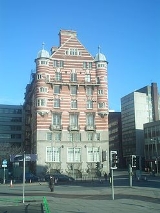
Albion House, Liverpool
Encyclopedia
Albion House is a Grade II* listed building located in Liverpool
, England
. It was constructed between 1896 and 1898 and is positioned on the corner of James Street and the Strand across from the Pier Head
.
s Richard Norman Shaw
and J. Francis Doyle
, it was built for the Ismay, Imrie and Company shipping company, which later became the White Star Line
. After White Star merged with Cunard Line
the headquarters remained at Albion House until 1927. The building is situated on the corner of The Strand and James Street. The facade is constructed from white Portland stone
and red brick. In 1912, when news of the disaster of the Titanic reached the offices, the officials were too afraid to leave the building, and instead read the names of the deceased from the balcony. During World War II
, the gable was damaged and was later rebuilt in the late 1940s.
Liverpool
Liverpool is a city and metropolitan borough of Merseyside, England, along the eastern side of the Mersey Estuary. It was founded as a borough in 1207 and was granted city status in 1880...
, England
England
England is a country that is part of the United Kingdom. It shares land borders with Scotland to the north and Wales to the west; the Irish Sea is to the north west, the Celtic Sea to the south west, with the North Sea to the east and the English Channel to the south separating it from continental...
. It was constructed between 1896 and 1898 and is positioned on the corner of James Street and the Strand across from the Pier Head
Pier Head
The Pier Head is a riverside location in the city centre of Liverpool, England. It is part of the Liverpool Maritime Mercantile City UNESCO World Heritage Site, which was inscribed in 2004....
.
History
Designed by architectArchitect
An architect is a person trained in the planning, design and oversight of the construction of buildings. To practice architecture means to offer or render services in connection with the design and construction of a building, or group of buildings and the space within the site surrounding the...
s Richard Norman Shaw
Richard Norman Shaw
Richard Norman Shaw RA , was an influential Scottish architect from the 1870s to the 1900s, known for his country houses and for commercial buildings.-Life:...
and J. Francis Doyle
James Francis Doyle
-Buildings:* Albion House Liverpool.* Royal Insurance Building, Liverpool.* St Ambrose.* Outpatient department, Liverpool Royal Infirmary. * St Barnabas, Mossley Hill.* Grand Hotel -References:...
, it was built for the Ismay, Imrie and Company shipping company, which later became the White Star Line
White Star Line
The Oceanic Steam Navigation Company or White Star Line of Boston Packets, more commonly known as the White Star Line, was a prominent British shipping company, today most famous for its ill-fated vessel, the RMS Titanic, and the World War I loss of Titanics sister ship Britannic...
. After White Star merged with Cunard Line
Cunard Line
Cunard Line is a British-American owned shipping company based at Carnival House in Southampton, England and operated by Carnival UK. It has been a leading operator of passenger ships on the North Atlantic for over a century...
the headquarters remained at Albion House until 1927. The building is situated on the corner of The Strand and James Street. The facade is constructed from white Portland stone
Portland stone
Portland stone is a limestone from the Tithonian stage of the Jurassic period quarried on the Isle of Portland, Dorset. The quarries consist of beds of white-grey limestone separated by chert beds. It has been used extensively as a building stone throughout the British Isles, notably in major...
and red brick. In 1912, when news of the disaster of the Titanic reached the offices, the officials were too afraid to leave the building, and instead read the names of the deceased from the balcony. During World War II
World War II
World War II, or the Second World War , was a global conflict lasting from 1939 to 1945, involving most of the world's nations—including all of the great powers—eventually forming two opposing military alliances: the Allies and the Axis...
, the gable was damaged and was later rebuilt in the late 1940s.

